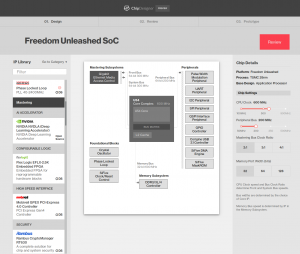 SiFive is a semi-conductor company that produces chips based on the RISC-V architecture. On May 15th, they organized a Technical Symposium in Grenoble on May 15th and we took the opportunity to attend, as the agenda looked interesting.
SiFive is a semi-conductor company that produces chips based on the RISC-V architecture. On May 15th, they organized a Technical Symposium in Grenoble on May 15th and we took the opportunity to attend, as the agenda looked interesting.
It was especially nice having Krste Asanovic present many of the topics, wearing different hats (RISC-V Foundation Chairman of the Board and SiFive Co-Founder and Chief Architect). The RISC-V architecture and its history and use cases were presented. One of the main benefit of having a brand new ISA (instruction set architecture), Asanovic said, is that it doesn’t have to handle legacy instructions and compatibility. Moreover, RISC-V is a frozen ISA, the base instructions are frozen and optional extensions which have been approved are also frozen. Finally, the ISA is open and anybody can implement a CPU core. During the presentation, the RISC-V ISA was (obviously) favorably compared to competing ISAs, mainly ARM.
Another interesting topic was the presentation of SiFive’s business model. They want anyone, including small companies to be able to design an SoC fitting their particular product, instead of having to choose from a set of more general purpose SoC. This can be done by using an existing SiFive RISC-V core or by customizing one. SiFive then offers a library of IPs that can be added on the SoC and third party IPs are available through their Designshare program. They handle NDA, contract and licensing and will collect non recurring engineering costs and royalties once the SoC is mass produced but not during the prototyping phase. They first provide virtualized chips and then sample chips. For the core, they also provide RTL that can run on FPGAs. For mass production, SiFive partnered with TSMC and their customers can benefit from their process (down to 7nm).
The most relevant topic for us was the software ecosystem. There is a very nice will to get code upstream and this is the case for GCC, binutils, newlib, gdb, glibc, qemu. Clang/LLVM is coming up. Regarding the Linux kernel port, it still requires some work as the core architecture support is there but no devices drivers or device tree support yet. There is however a fully working vendor tree. FreeBSD seems to be in the same state.
Most of the remaining time was focused on the design and customization tool available here.

SiFive also Sponsored Linus Sebastian (from Linus Tech Tips) for a video:
To conclude, it was an very interesting day. At Bootlin, we are delighted to see architecture designers and silicon vendors actively pushing software support upstream and we are looking forward to work on RISC-V platforms.

How about some embedded Linux or RTOS training on RISC-V architecture? I personally will be very interested. 🙂